Healthcare Report: Promoting Positive Behaviour and Safeguarding
VerifiedAdded on 2020/07/23
|9
|2368
|720
Report
AI Summary
This report delves into the crucial aspects of promoting positive behavior within the healthcare sector, emphasizing the importance of legislation, interventions, and safeguarding measures. It examines relevant laws such as the Criminal Law Act 1967, Health and Safety regulations, and the Human Rights Act 1998, highlighting their role in ensuring a safe and disciplined environment. The report discusses the use of Fundamental Behavioural Analysis (FBA) to understand and address challenging behaviors, as well as the implementation of least restrictive interventions. It stresses the significance of maintaining a person- or child-centered approach through proactive strategies, and the importance of maintaining dignity and respect when responding to challenging behaviors. The report also identifies different types of challenging behaviors and outlines the steps necessary to check on an individual's well-being following an incident. Overall, this report provides a comprehensive overview of strategies and regulations aimed at improving the quality of care and fostering a positive environment within healthcare settings.
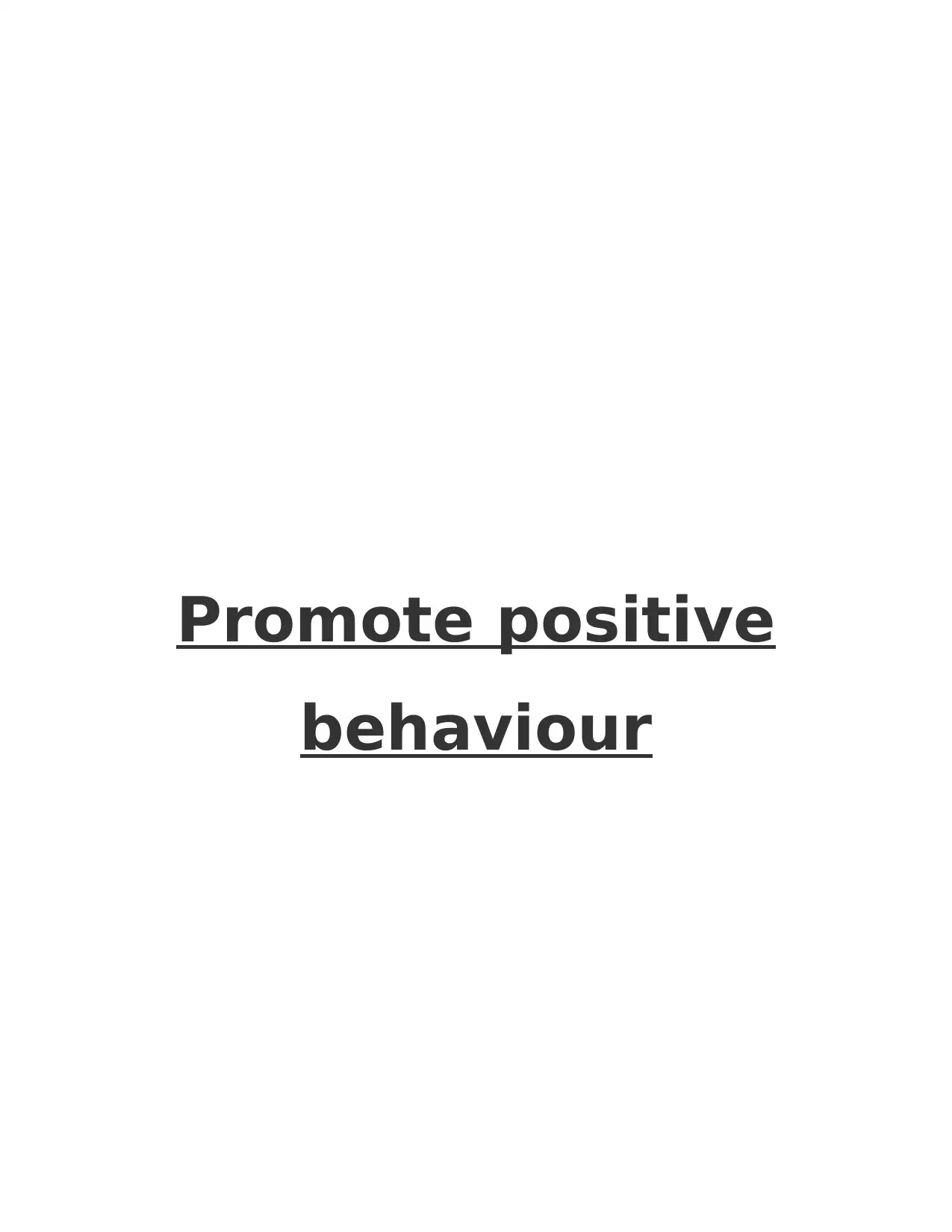
Promote positive
behaviour
behaviour
Paraphrase This Document
Need a fresh take? Get an instant paraphrase of this document with our AI Paraphraser
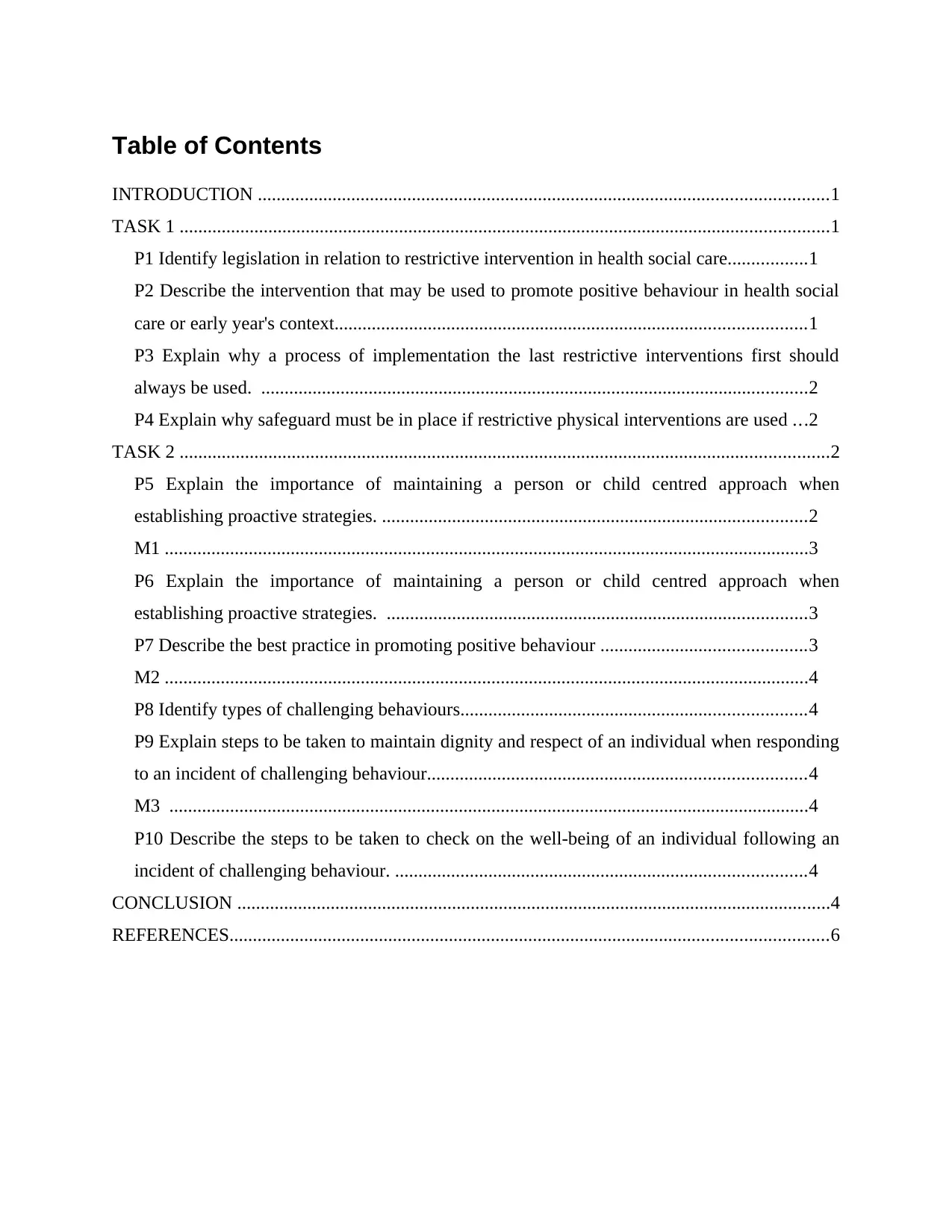
Table of Contents
INTRODUCTION ..........................................................................................................................1
TASK 1 ...........................................................................................................................................1
P1 Identify legislation in relation to restrictive intervention in health social care.................1
P2 Describe the intervention that may be used to promote positive behaviour in health social
care or early year's context.....................................................................................................1
P3 Explain why a process of implementation the last restrictive interventions first should
always be used. .....................................................................................................................2
P4 Explain why safeguard must be in place if restrictive physical interventions are used ...2
TASK 2 ...........................................................................................................................................2
P5 Explain the importance of maintaining a person or child centred approach when
establishing proactive strategies. ...........................................................................................2
M1 ..........................................................................................................................................3
P6 Explain the importance of maintaining a person or child centred approach when
establishing proactive strategies. ..........................................................................................3
P7 Describe the best practice in promoting positive behaviour ............................................3
M2 ..........................................................................................................................................4
P8 Identify types of challenging behaviours..........................................................................4
P9 Explain steps to be taken to maintain dignity and respect of an individual when responding
to an incident of challenging behaviour.................................................................................4
M3 .........................................................................................................................................4
P10 Describe the steps to be taken to check on the well-being of an individual following an
incident of challenging behaviour. ........................................................................................4
CONCLUSION ...............................................................................................................................4
REFERENCES................................................................................................................................6
INTRODUCTION ..........................................................................................................................1
TASK 1 ...........................................................................................................................................1
P1 Identify legislation in relation to restrictive intervention in health social care.................1
P2 Describe the intervention that may be used to promote positive behaviour in health social
care or early year's context.....................................................................................................1
P3 Explain why a process of implementation the last restrictive interventions first should
always be used. .....................................................................................................................2
P4 Explain why safeguard must be in place if restrictive physical interventions are used ...2
TASK 2 ...........................................................................................................................................2
P5 Explain the importance of maintaining a person or child centred approach when
establishing proactive strategies. ...........................................................................................2
M1 ..........................................................................................................................................3
P6 Explain the importance of maintaining a person or child centred approach when
establishing proactive strategies. ..........................................................................................3
P7 Describe the best practice in promoting positive behaviour ............................................3
M2 ..........................................................................................................................................4
P8 Identify types of challenging behaviours..........................................................................4
P9 Explain steps to be taken to maintain dignity and respect of an individual when responding
to an incident of challenging behaviour.................................................................................4
M3 .........................................................................................................................................4
P10 Describe the steps to be taken to check on the well-being of an individual following an
incident of challenging behaviour. ........................................................................................4
CONCLUSION ...............................................................................................................................4
REFERENCES................................................................................................................................6
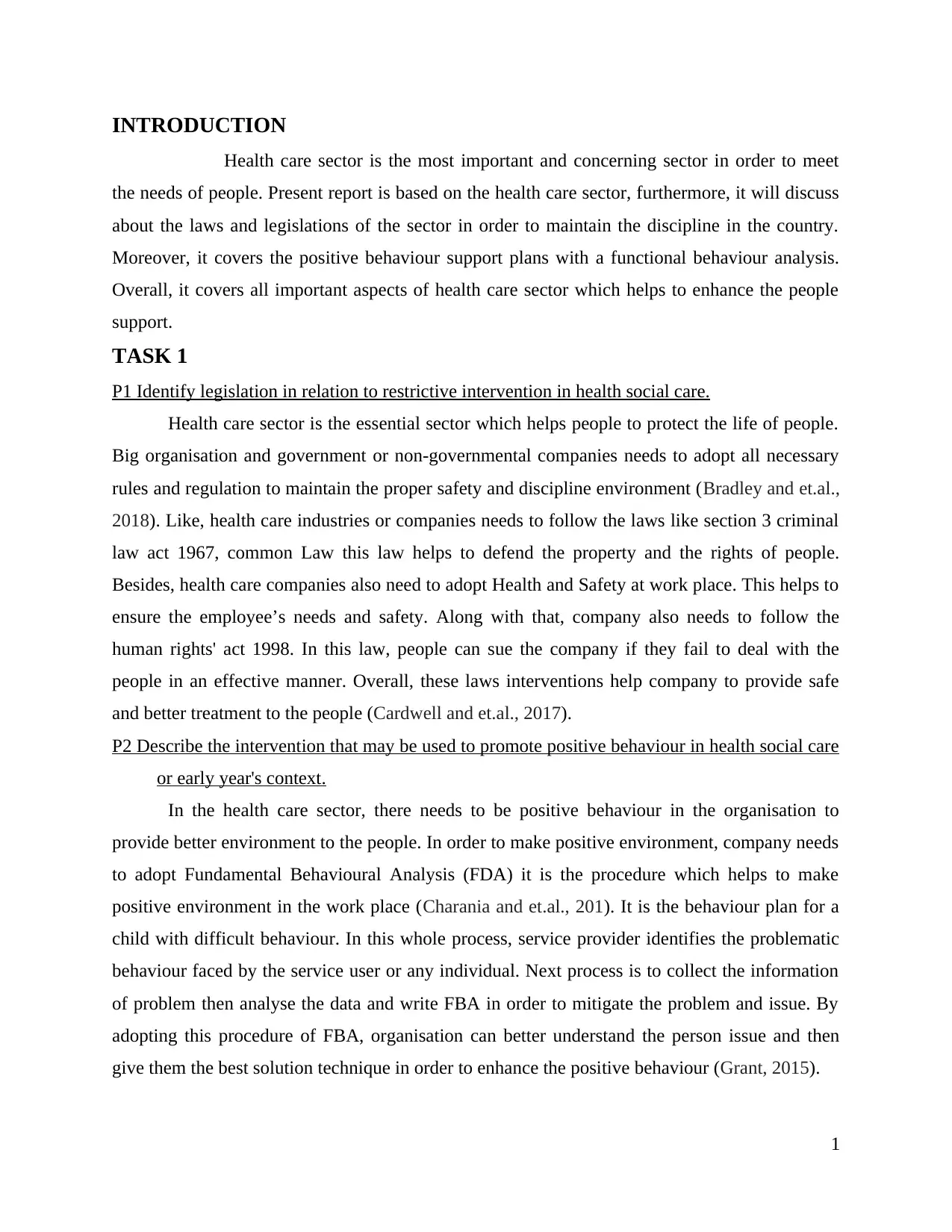
INTRODUCTION
Health care sector is the most important and concerning sector in order to meet
the needs of people. Present report is based on the health care sector, furthermore, it will discuss
about the laws and legislations of the sector in order to maintain the discipline in the country.
Moreover, it covers the positive behaviour support plans with a functional behaviour analysis.
Overall, it covers all important aspects of health care sector which helps to enhance the people
support.
TASK 1
P1 Identify legislation in relation to restrictive intervention in health social care.
Health care sector is the essential sector which helps people to protect the life of people.
Big organisation and government or non-governmental companies needs to adopt all necessary
rules and regulation to maintain the proper safety and discipline environment (Bradley and et.al.,
2018). Like, health care industries or companies needs to follow the laws like section 3 criminal
law act 1967, common Law this law helps to defend the property and the rights of people.
Besides, health care companies also need to adopt Health and Safety at work place. This helps to
ensure the employee’s needs and safety. Along with that, company also needs to follow the
human rights' act 1998. In this law, people can sue the company if they fail to deal with the
people in an effective manner. Overall, these laws interventions help company to provide safe
and better treatment to the people (Cardwell and et.al., 2017).
P2 Describe the intervention that may be used to promote positive behaviour in health social care
or early year's context.
In the health care sector, there needs to be positive behaviour in the organisation to
provide better environment to the people. In order to make positive environment, company needs
to adopt Fundamental Behavioural Analysis (FDA) it is the procedure which helps to make
positive environment in the work place (Charania and et.al., 201). It is the behaviour plan for a
child with difficult behaviour. In this whole process, service provider identifies the problematic
behaviour faced by the service user or any individual. Next process is to collect the information
of problem then analyse the data and write FBA in order to mitigate the problem and issue. By
adopting this procedure of FBA, organisation can better understand the person issue and then
give them the best solution technique in order to enhance the positive behaviour (Grant, 2015).
1
Health care sector is the most important and concerning sector in order to meet
the needs of people. Present report is based on the health care sector, furthermore, it will discuss
about the laws and legislations of the sector in order to maintain the discipline in the country.
Moreover, it covers the positive behaviour support plans with a functional behaviour analysis.
Overall, it covers all important aspects of health care sector which helps to enhance the people
support.
TASK 1
P1 Identify legislation in relation to restrictive intervention in health social care.
Health care sector is the essential sector which helps people to protect the life of people.
Big organisation and government or non-governmental companies needs to adopt all necessary
rules and regulation to maintain the proper safety and discipline environment (Bradley and et.al.,
2018). Like, health care industries or companies needs to follow the laws like section 3 criminal
law act 1967, common Law this law helps to defend the property and the rights of people.
Besides, health care companies also need to adopt Health and Safety at work place. This helps to
ensure the employee’s needs and safety. Along with that, company also needs to follow the
human rights' act 1998. In this law, people can sue the company if they fail to deal with the
people in an effective manner. Overall, these laws interventions help company to provide safe
and better treatment to the people (Cardwell and et.al., 2017).
P2 Describe the intervention that may be used to promote positive behaviour in health social care
or early year's context.
In the health care sector, there needs to be positive behaviour in the organisation to
provide better environment to the people. In order to make positive environment, company needs
to adopt Fundamental Behavioural Analysis (FDA) it is the procedure which helps to make
positive environment in the work place (Charania and et.al., 201). It is the behaviour plan for a
child with difficult behaviour. In this whole process, service provider identifies the problematic
behaviour faced by the service user or any individual. Next process is to collect the information
of problem then analyse the data and write FBA in order to mitigate the problem and issue. By
adopting this procedure of FBA, organisation can better understand the person issue and then
give them the best solution technique in order to enhance the positive behaviour (Grant, 2015).
1
⊘ This is a preview!⊘
Do you want full access?
Subscribe today to unlock all pages.

Trusted by 1+ million students worldwide
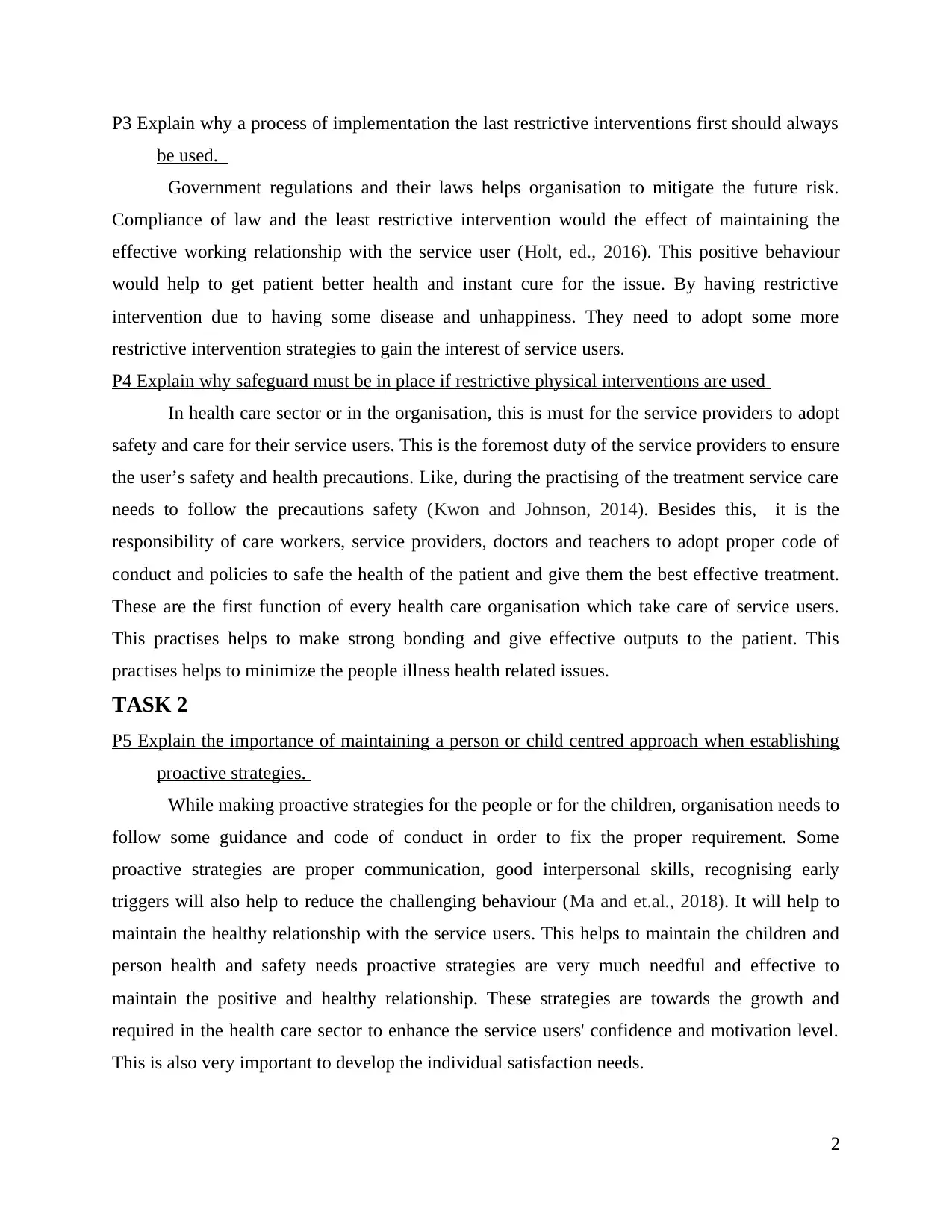
P3 Explain why a process of implementation the last restrictive interventions first should always
be used.
Government regulations and their laws helps organisation to mitigate the future risk.
Compliance of law and the least restrictive intervention would the effect of maintaining the
effective working relationship with the service user (Holt, ed., 2016). This positive behaviour
would help to get patient better health and instant cure for the issue. By having restrictive
intervention due to having some disease and unhappiness. They need to adopt some more
restrictive intervention strategies to gain the interest of service users.
P4 Explain why safeguard must be in place if restrictive physical interventions are used
In health care sector or in the organisation, this is must for the service providers to adopt
safety and care for their service users. This is the foremost duty of the service providers to ensure
the user’s safety and health precautions. Like, during the practising of the treatment service care
needs to follow the precautions safety (Kwon and Johnson, 2014). Besides this, it is the
responsibility of care workers, service providers, doctors and teachers to adopt proper code of
conduct and policies to safe the health of the patient and give them the best effective treatment.
These are the first function of every health care organisation which take care of service users.
This practises helps to make strong bonding and give effective outputs to the patient. This
practises helps to minimize the people illness health related issues.
TASK 2
P5 Explain the importance of maintaining a person or child centred approach when establishing
proactive strategies.
While making proactive strategies for the people or for the children, organisation needs to
follow some guidance and code of conduct in order to fix the proper requirement. Some
proactive strategies are proper communication, good interpersonal skills, recognising early
triggers will also help to reduce the challenging behaviour (Ma and et.al., 2018). It will help to
maintain the healthy relationship with the service users. This helps to maintain the children and
person health and safety needs proactive strategies are very much needful and effective to
maintain the positive and healthy relationship. These strategies are towards the growth and
required in the health care sector to enhance the service users' confidence and motivation level.
This is also very important to develop the individual satisfaction needs.
2
be used.
Government regulations and their laws helps organisation to mitigate the future risk.
Compliance of law and the least restrictive intervention would the effect of maintaining the
effective working relationship with the service user (Holt, ed., 2016). This positive behaviour
would help to get patient better health and instant cure for the issue. By having restrictive
intervention due to having some disease and unhappiness. They need to adopt some more
restrictive intervention strategies to gain the interest of service users.
P4 Explain why safeguard must be in place if restrictive physical interventions are used
In health care sector or in the organisation, this is must for the service providers to adopt
safety and care for their service users. This is the foremost duty of the service providers to ensure
the user’s safety and health precautions. Like, during the practising of the treatment service care
needs to follow the precautions safety (Kwon and Johnson, 2014). Besides this, it is the
responsibility of care workers, service providers, doctors and teachers to adopt proper code of
conduct and policies to safe the health of the patient and give them the best effective treatment.
These are the first function of every health care organisation which take care of service users.
This practises helps to make strong bonding and give effective outputs to the patient. This
practises helps to minimize the people illness health related issues.
TASK 2
P5 Explain the importance of maintaining a person or child centred approach when establishing
proactive strategies.
While making proactive strategies for the people or for the children, organisation needs to
follow some guidance and code of conduct in order to fix the proper requirement. Some
proactive strategies are proper communication, good interpersonal skills, recognising early
triggers will also help to reduce the challenging behaviour (Ma and et.al., 2018). It will help to
maintain the healthy relationship with the service users. This helps to maintain the children and
person health and safety needs proactive strategies are very much needful and effective to
maintain the positive and healthy relationship. These strategies are towards the growth and
required in the health care sector to enhance the service users' confidence and motivation level.
This is also very important to develop the individual satisfaction needs.
2
Paraphrase This Document
Need a fresh take? Get an instant paraphrase of this document with our AI Paraphraser
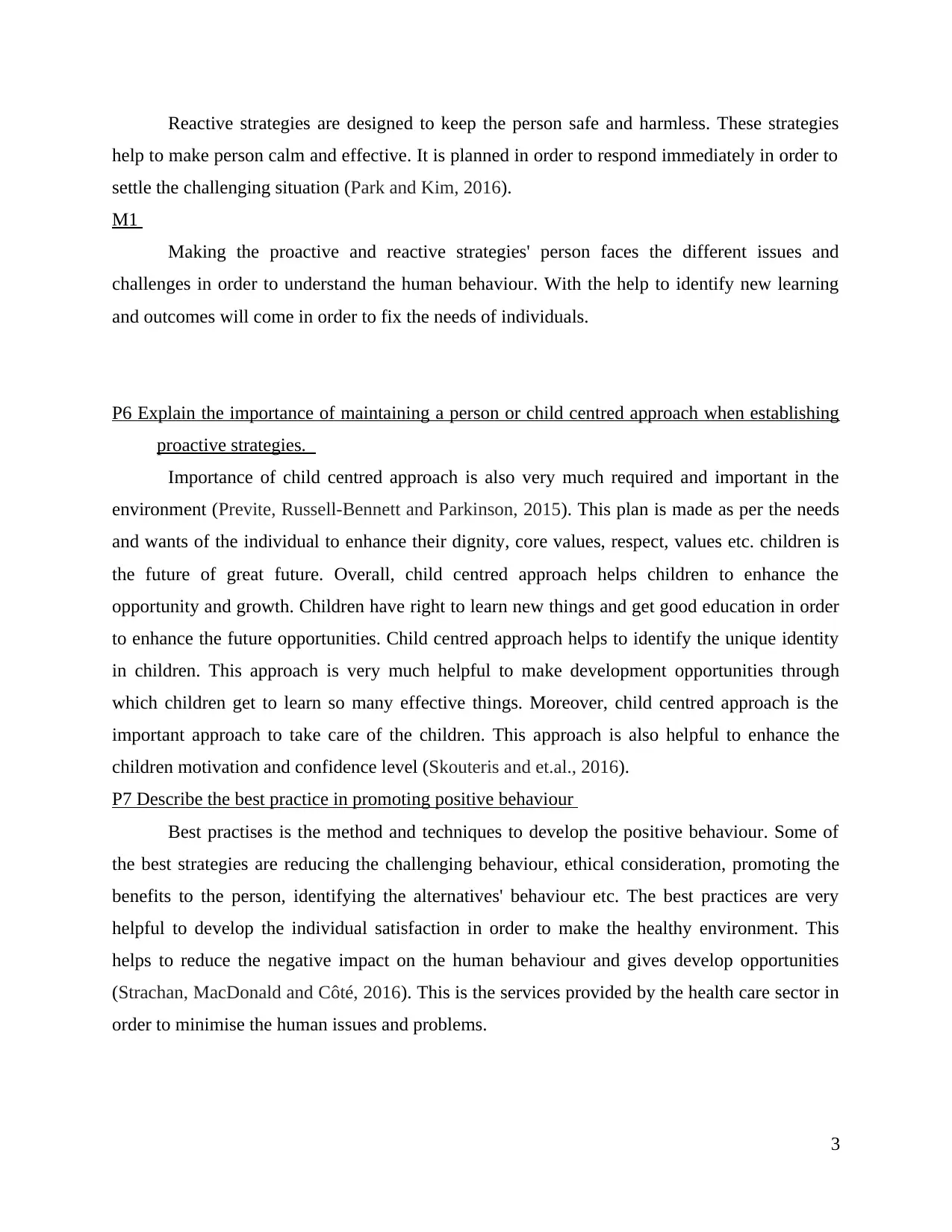
Reactive strategies are designed to keep the person safe and harmless. These strategies
help to make person calm and effective. It is planned in order to respond immediately in order to
settle the challenging situation (Park and Kim, 2016).
M1
Making the proactive and reactive strategies' person faces the different issues and
challenges in order to understand the human behaviour. With the help to identify new learning
and outcomes will come in order to fix the needs of individuals.
P6 Explain the importance of maintaining a person or child centred approach when establishing
proactive strategies.
Importance of child centred approach is also very much required and important in the
environment (Previte, Russell‐Bennett and Parkinson, 2015). This plan is made as per the needs
and wants of the individual to enhance their dignity, core values, respect, values etc. children is
the future of great future. Overall, child centred approach helps children to enhance the
opportunity and growth. Children have right to learn new things and get good education in order
to enhance the future opportunities. Child centred approach helps to identify the unique identity
in children. This approach is very much helpful to make development opportunities through
which children get to learn so many effective things. Moreover, child centred approach is the
important approach to take care of the children. This approach is also helpful to enhance the
children motivation and confidence level (Skouteris and et.al., 2016).
P7 Describe the best practice in promoting positive behaviour
Best practises is the method and techniques to develop the positive behaviour. Some of
the best strategies are reducing the challenging behaviour, ethical consideration, promoting the
benefits to the person, identifying the alternatives' behaviour etc. The best practices are very
helpful to develop the individual satisfaction in order to make the healthy environment. This
helps to reduce the negative impact on the human behaviour and gives develop opportunities
(Strachan, MacDonald and Côté, 2016). This is the services provided by the health care sector in
order to minimise the human issues and problems.
3
help to make person calm and effective. It is planned in order to respond immediately in order to
settle the challenging situation (Park and Kim, 2016).
M1
Making the proactive and reactive strategies' person faces the different issues and
challenges in order to understand the human behaviour. With the help to identify new learning
and outcomes will come in order to fix the needs of individuals.
P6 Explain the importance of maintaining a person or child centred approach when establishing
proactive strategies.
Importance of child centred approach is also very much required and important in the
environment (Previte, Russell‐Bennett and Parkinson, 2015). This plan is made as per the needs
and wants of the individual to enhance their dignity, core values, respect, values etc. children is
the future of great future. Overall, child centred approach helps children to enhance the
opportunity and growth. Children have right to learn new things and get good education in order
to enhance the future opportunities. Child centred approach helps to identify the unique identity
in children. This approach is very much helpful to make development opportunities through
which children get to learn so many effective things. Moreover, child centred approach is the
important approach to take care of the children. This approach is also helpful to enhance the
children motivation and confidence level (Skouteris and et.al., 2016).
P7 Describe the best practice in promoting positive behaviour
Best practises is the method and techniques to develop the positive behaviour. Some of
the best strategies are reducing the challenging behaviour, ethical consideration, promoting the
benefits to the person, identifying the alternatives' behaviour etc. The best practices are very
helpful to develop the individual satisfaction in order to make the healthy environment. This
helps to reduce the negative impact on the human behaviour and gives develop opportunities
(Strachan, MacDonald and Côté, 2016). This is the services provided by the health care sector in
order to minimise the human issues and problems.
3
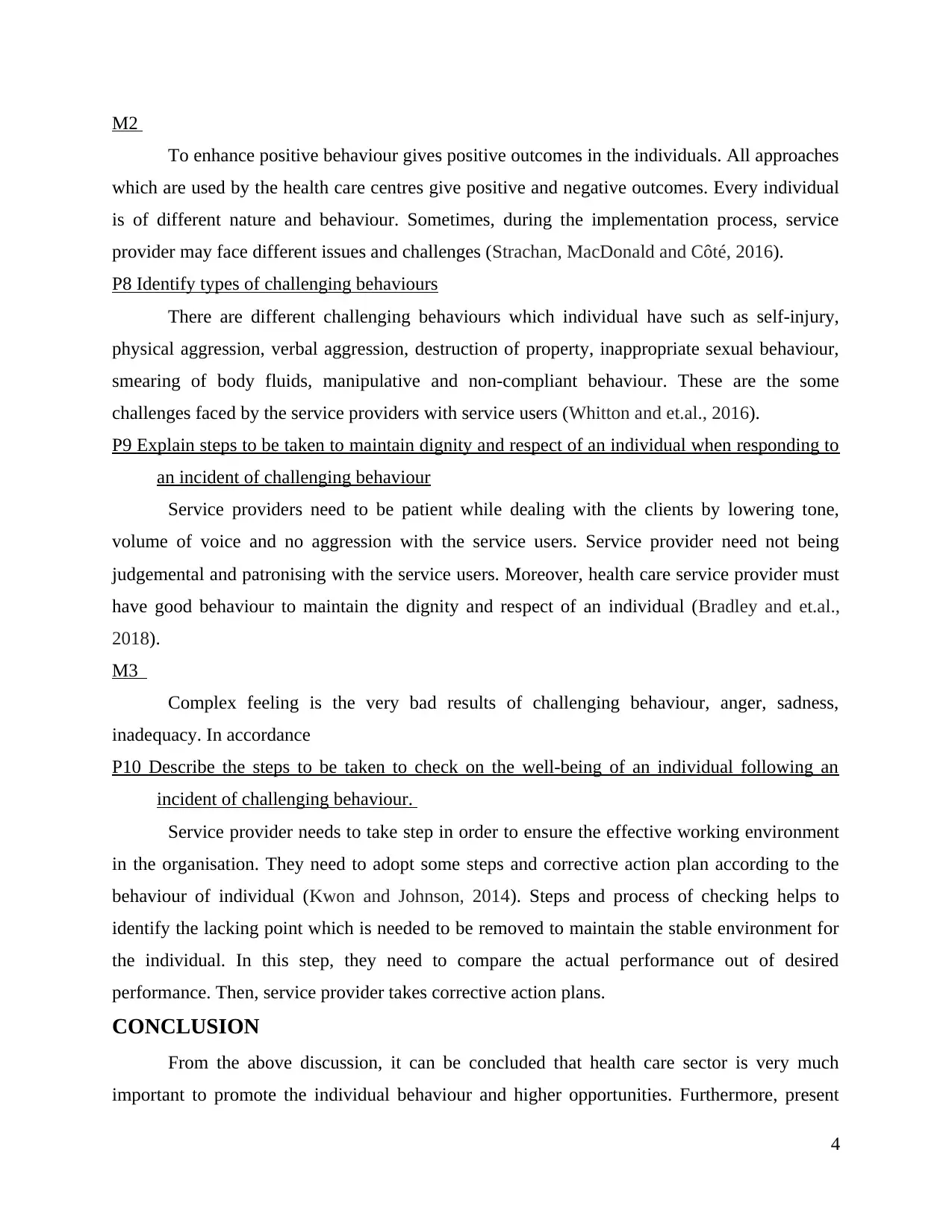
M2
To enhance positive behaviour gives positive outcomes in the individuals. All approaches
which are used by the health care centres give positive and negative outcomes. Every individual
is of different nature and behaviour. Sometimes, during the implementation process, service
provider may face different issues and challenges (Strachan, MacDonald and Côté, 2016).
P8 Identify types of challenging behaviours
There are different challenging behaviours which individual have such as self-injury,
physical aggression, verbal aggression, destruction of property, inappropriate sexual behaviour,
smearing of body fluids, manipulative and non-compliant behaviour. These are the some
challenges faced by the service providers with service users (Whitton and et.al., 2016).
P9 Explain steps to be taken to maintain dignity and respect of an individual when responding to
an incident of challenging behaviour
Service providers need to be patient while dealing with the clients by lowering tone,
volume of voice and no aggression with the service users. Service provider need not being
judgemental and patronising with the service users. Moreover, health care service provider must
have good behaviour to maintain the dignity and respect of an individual (Bradley and et.al.,
2018).
M3
Complex feeling is the very bad results of challenging behaviour, anger, sadness,
inadequacy. In accordance
P10 Describe the steps to be taken to check on the well-being of an individual following an
incident of challenging behaviour.
Service provider needs to take step in order to ensure the effective working environment
in the organisation. They need to adopt some steps and corrective action plan according to the
behaviour of individual (Kwon and Johnson, 2014). Steps and process of checking helps to
identify the lacking point which is needed to be removed to maintain the stable environment for
the individual. In this step, they need to compare the actual performance out of desired
performance. Then, service provider takes corrective action plans.
CONCLUSION
From the above discussion, it can be concluded that health care sector is very much
important to promote the individual behaviour and higher opportunities. Furthermore, present
4
To enhance positive behaviour gives positive outcomes in the individuals. All approaches
which are used by the health care centres give positive and negative outcomes. Every individual
is of different nature and behaviour. Sometimes, during the implementation process, service
provider may face different issues and challenges (Strachan, MacDonald and Côté, 2016).
P8 Identify types of challenging behaviours
There are different challenging behaviours which individual have such as self-injury,
physical aggression, verbal aggression, destruction of property, inappropriate sexual behaviour,
smearing of body fluids, manipulative and non-compliant behaviour. These are the some
challenges faced by the service providers with service users (Whitton and et.al., 2016).
P9 Explain steps to be taken to maintain dignity and respect of an individual when responding to
an incident of challenging behaviour
Service providers need to be patient while dealing with the clients by lowering tone,
volume of voice and no aggression with the service users. Service provider need not being
judgemental and patronising with the service users. Moreover, health care service provider must
have good behaviour to maintain the dignity and respect of an individual (Bradley and et.al.,
2018).
M3
Complex feeling is the very bad results of challenging behaviour, anger, sadness,
inadequacy. In accordance
P10 Describe the steps to be taken to check on the well-being of an individual following an
incident of challenging behaviour.
Service provider needs to take step in order to ensure the effective working environment
in the organisation. They need to adopt some steps and corrective action plan according to the
behaviour of individual (Kwon and Johnson, 2014). Steps and process of checking helps to
identify the lacking point which is needed to be removed to maintain the stable environment for
the individual. In this step, they need to compare the actual performance out of desired
performance. Then, service provider takes corrective action plans.
CONCLUSION
From the above discussion, it can be concluded that health care sector is very much
important to promote the individual behaviour and higher opportunities. Furthermore, present
4
⊘ This is a preview!⊘
Do you want full access?
Subscribe today to unlock all pages.

Trusted by 1+ million students worldwide
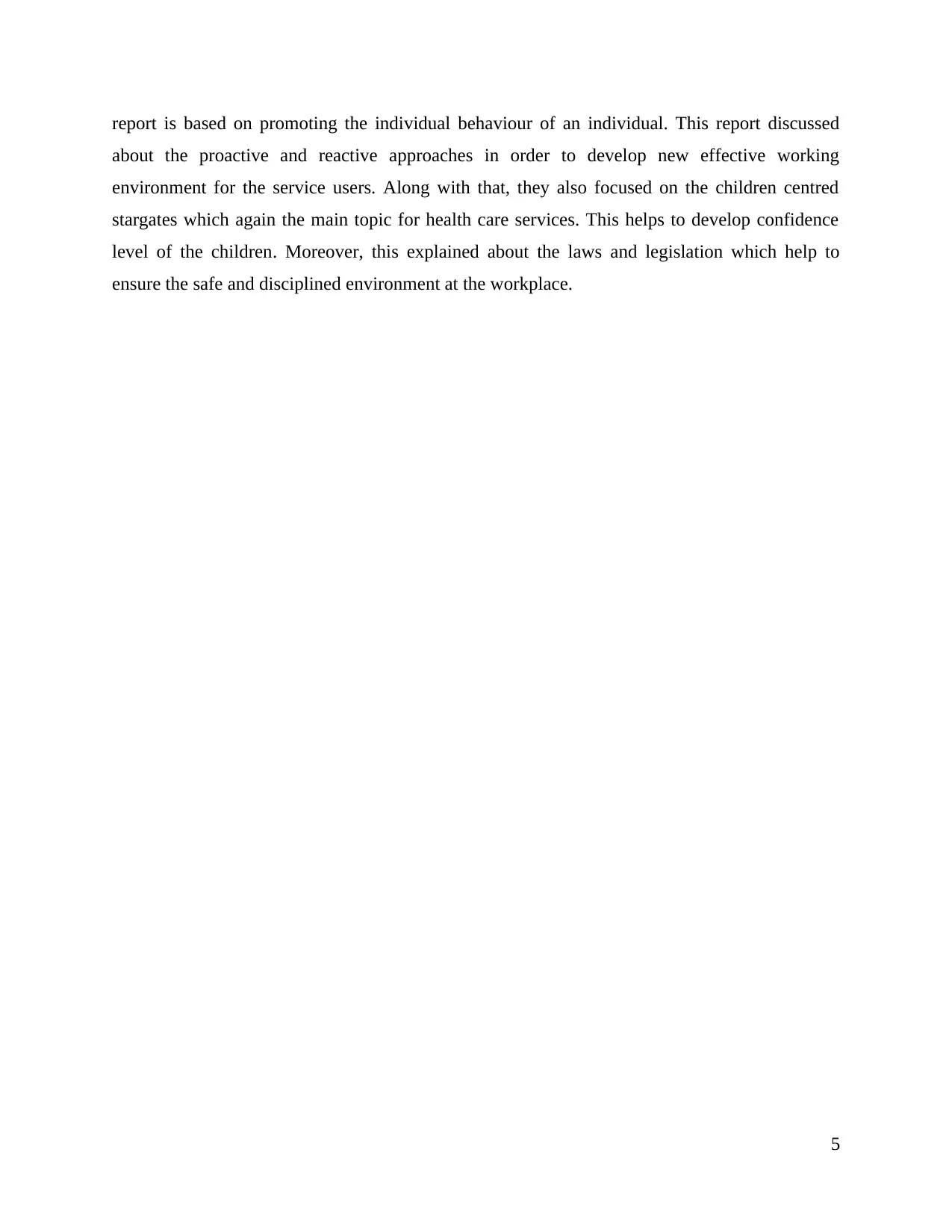
report is based on promoting the individual behaviour of an individual. This report discussed
about the proactive and reactive approaches in order to develop new effective working
environment for the service users. Along with that, they also focused on the children centred
stargates which again the main topic for health care services. This helps to develop confidence
level of the children. Moreover, this explained about the laws and legislation which help to
ensure the safe and disciplined environment at the workplace.
5
about the proactive and reactive approaches in order to develop new effective working
environment for the service users. Along with that, they also focused on the children centred
stargates which again the main topic for health care services. This helps to develop confidence
level of the children. Moreover, this explained about the laws and legislation which help to
ensure the safe and disciplined environment at the workplace.
5
Paraphrase This Document
Need a fresh take? Get an instant paraphrase of this document with our AI Paraphraser
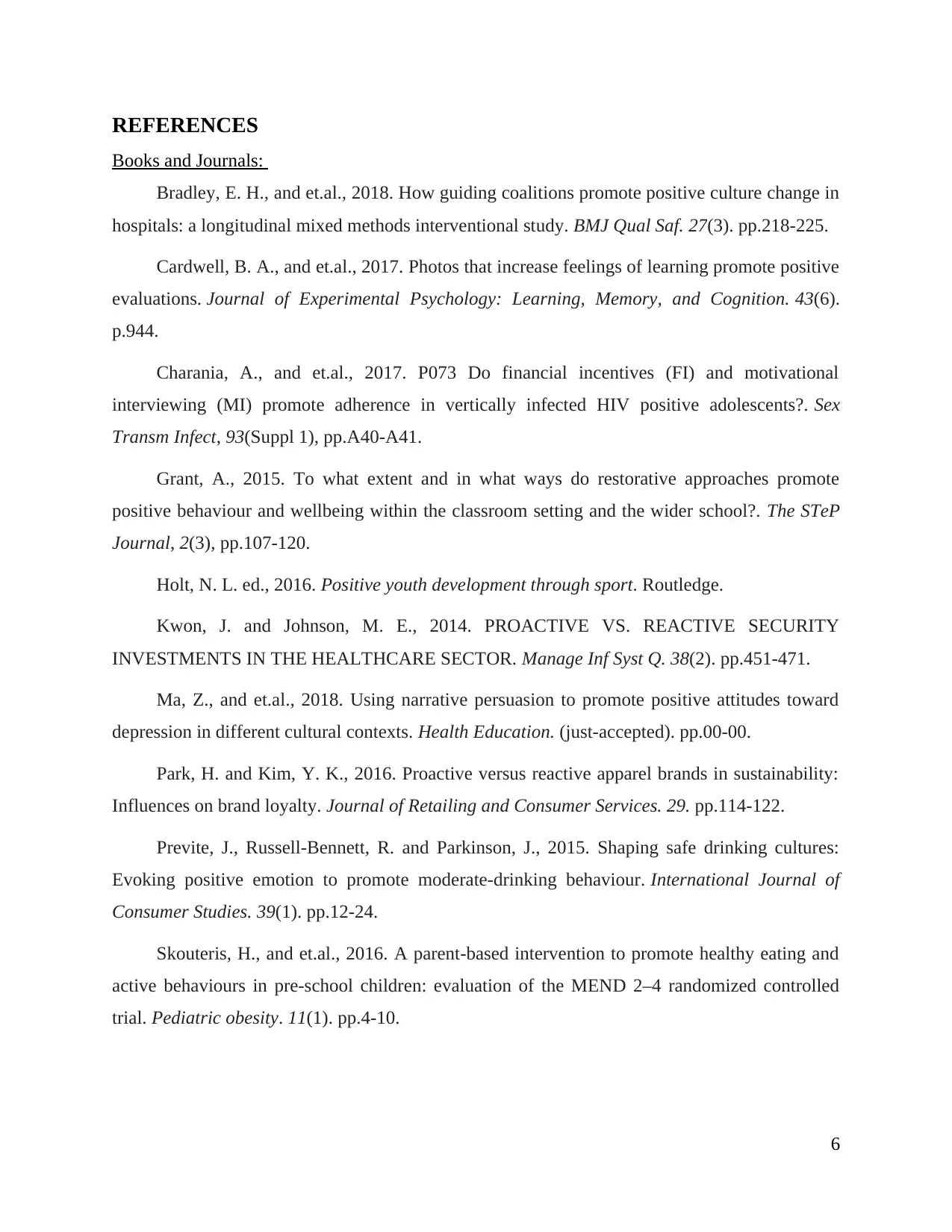
REFERENCES
Books and Journals:
Bradley, E. H., and et.al., 2018. How guiding coalitions promote positive culture change in
hospitals: a longitudinal mixed methods interventional study. BMJ Qual Saf. 27(3). pp.218-225.
Cardwell, B. A., and et.al., 2017. Photos that increase feelings of learning promote positive
evaluations. Journal of Experimental Psychology: Learning, Memory, and Cognition. 43(6).
p.944.
Charania, A., and et.al., 2017. P073 Do financial incentives (FI) and motivational
interviewing (MI) promote adherence in vertically infected HIV positive adolescents?. Sex
Transm Infect, 93(Suppl 1), pp.A40-A41.
Grant, A., 2015. To what extent and in what ways do restorative approaches promote
positive behaviour and wellbeing within the classroom setting and the wider school?. The STeP
Journal, 2(3), pp.107-120.
Holt, N. L. ed., 2016. Positive youth development through sport. Routledge.
Kwon, J. and Johnson, M. E., 2014. PROACTIVE VS. REACTIVE SECURITY
INVESTMENTS IN THE HEALTHCARE SECTOR. Manage Inf Syst Q. 38(2). pp.451-471.
Ma, Z., and et.al., 2018. Using narrative persuasion to promote positive attitudes toward
depression in different cultural contexts. Health Education. (just-accepted). pp.00-00.
Park, H. and Kim, Y. K., 2016. Proactive versus reactive apparel brands in sustainability:
Influences on brand loyalty. Journal of Retailing and Consumer Services. 29. pp.114-122.
Previte, J., Russell‐Bennett, R. and Parkinson, J., 2015. Shaping safe drinking cultures:
Evoking positive emotion to promote moderate‐drinking behaviour. International Journal of
Consumer Studies. 39(1). pp.12-24.
Skouteris, H., and et.al., 2016. A parent‐based intervention to promote healthy eating and
active behaviours in pre‐school children: evaluation of the MEND 2–4 randomized controlled
trial. Pediatric obesity. 11(1). pp.4-10.
6
Books and Journals:
Bradley, E. H., and et.al., 2018. How guiding coalitions promote positive culture change in
hospitals: a longitudinal mixed methods interventional study. BMJ Qual Saf. 27(3). pp.218-225.
Cardwell, B. A., and et.al., 2017. Photos that increase feelings of learning promote positive
evaluations. Journal of Experimental Psychology: Learning, Memory, and Cognition. 43(6).
p.944.
Charania, A., and et.al., 2017. P073 Do financial incentives (FI) and motivational
interviewing (MI) promote adherence in vertically infected HIV positive adolescents?. Sex
Transm Infect, 93(Suppl 1), pp.A40-A41.
Grant, A., 2015. To what extent and in what ways do restorative approaches promote
positive behaviour and wellbeing within the classroom setting and the wider school?. The STeP
Journal, 2(3), pp.107-120.
Holt, N. L. ed., 2016. Positive youth development through sport. Routledge.
Kwon, J. and Johnson, M. E., 2014. PROACTIVE VS. REACTIVE SECURITY
INVESTMENTS IN THE HEALTHCARE SECTOR. Manage Inf Syst Q. 38(2). pp.451-471.
Ma, Z., and et.al., 2018. Using narrative persuasion to promote positive attitudes toward
depression in different cultural contexts. Health Education. (just-accepted). pp.00-00.
Park, H. and Kim, Y. K., 2016. Proactive versus reactive apparel brands in sustainability:
Influences on brand loyalty. Journal of Retailing and Consumer Services. 29. pp.114-122.
Previte, J., Russell‐Bennett, R. and Parkinson, J., 2015. Shaping safe drinking cultures:
Evoking positive emotion to promote moderate‐drinking behaviour. International Journal of
Consumer Studies. 39(1). pp.12-24.
Skouteris, H., and et.al., 2016. A parent‐based intervention to promote healthy eating and
active behaviours in pre‐school children: evaluation of the MEND 2–4 randomized controlled
trial. Pediatric obesity. 11(1). pp.4-10.
6
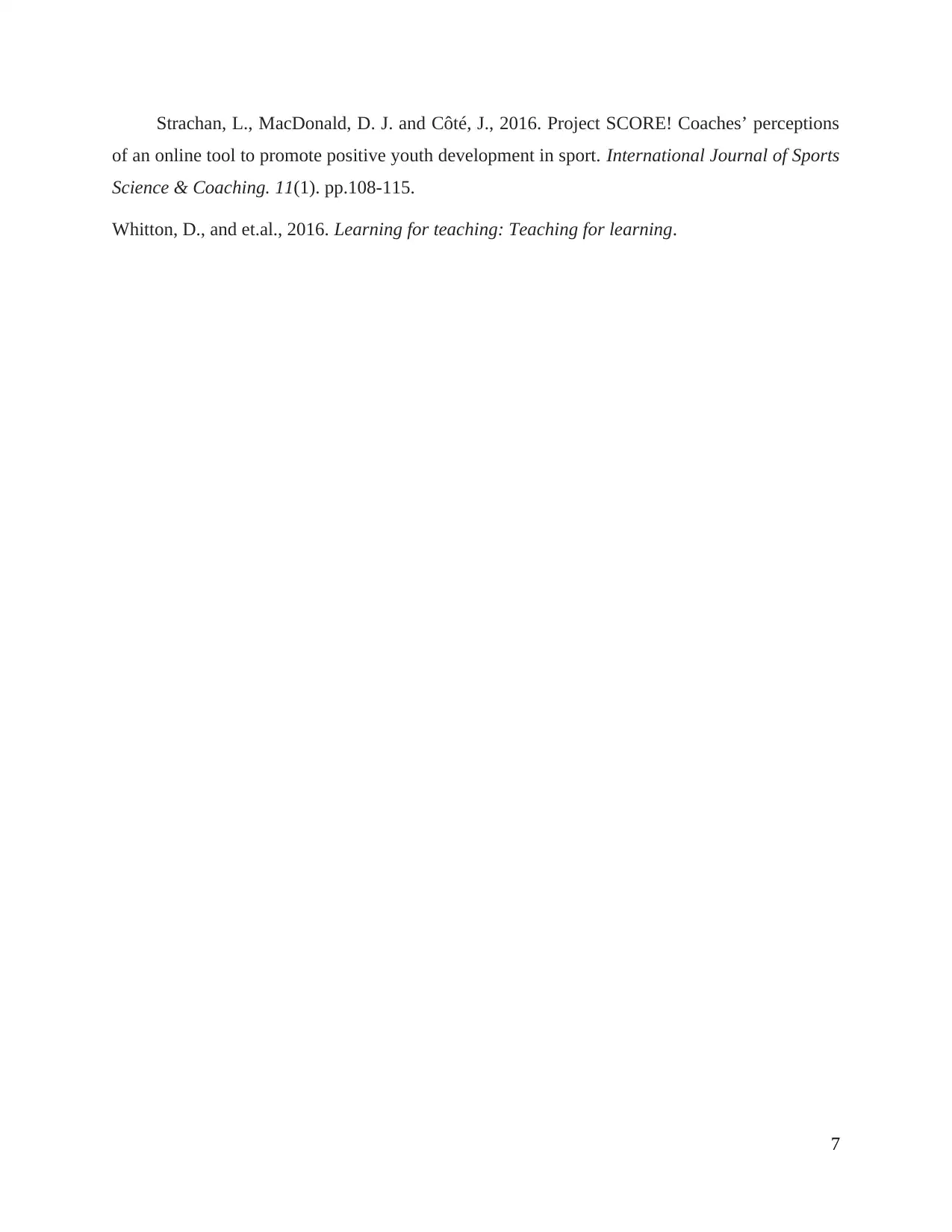
Strachan, L., MacDonald, D. J. and Côté, J., 2016. Project SCORE! Coaches’ perceptions
of an online tool to promote positive youth development in sport. International Journal of Sports
Science & Coaching. 11(1). pp.108-115.
Whitton, D., and et.al., 2016. Learning for teaching: Teaching for learning.
7
of an online tool to promote positive youth development in sport. International Journal of Sports
Science & Coaching. 11(1). pp.108-115.
Whitton, D., and et.al., 2016. Learning for teaching: Teaching for learning.
7
⊘ This is a preview!⊘
Do you want full access?
Subscribe today to unlock all pages.

Trusted by 1+ million students worldwide
1 out of 9
Related Documents
Your All-in-One AI-Powered Toolkit for Academic Success.
+13062052269
info@desklib.com
Available 24*7 on WhatsApp / Email
![[object Object]](/_next/static/media/star-bottom.7253800d.svg)
Unlock your academic potential
Copyright © 2020–2025 A2Z Services. All Rights Reserved. Developed and managed by ZUCOL.





